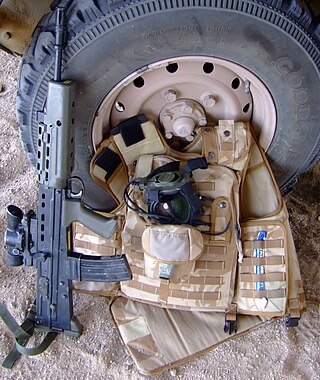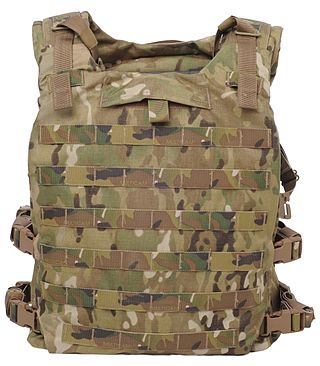
A bulletproof vest, also known as a ballistic vest or a bullet-resistant vest, is an item of body armour that helps absorb the impact and reduce or stop penetration to the torso by firearm-fired projectiles and fragmentation from explosions. The vest may come in a soft form, as worn by many police officers, prison officers, security guards, and some private citizens, used to protect against stabbing attacks or light projectiles, or hard form, using metallic or para-aramid components. Soldiers and police tactical units wear hard armour, either in conjunction with soft armour or alone, to protect against rifle ammunition or fragmentation.
The Interceptor Multi-Threat Body Armor System (IBA) is a bullet-resistant body armor system that was used by the United States Armed Forces during the 2000s, with some limited usage into the mid-2010s. IBA and its design replaced the older standardized fragmentation protective Personnel Armor System for Ground Troops (PASGT) body armor system that was designed in the late 1970s and introduced in the early 1980s.

MOLLE is an acronym for Modular Lightweight Load-carrying Equipment. It is used to define the current generation of load-bearing equipment and backpacks used by a number of NATO armed forces, especially the British Army and the United States Army.

Personnel Armor System for Ground Troops is a combat helmet and ballistic vest that was used by the United States military from the early 1980s until the mid-2000s, when the helmet and vest were succeeded by the Lightweight Helmet (LWH), Modular Integrated Communications Helmet (MICH), and Interceptor Body Armor (IBA) respectively.

A flak jacket or flak vest is a form of body armor. A flak jacket is designed to provide protection from case fragments ("frag") from high explosive weaponry, such as anti-aircraft artillery, grenade fragments, some types of pellets used in shotguns, and other lower-velocity projectiles. It is not designed to protect against bullets fired from most small arms such as rifles or handguns. However flak jackets are able to sustain certain gunshots, depending on the angle at which the shot was fired, the caliber of the bullet, the speed of the projectile and the range from which the shot was fired.

Body armor, personal armor, armored suit (armoured) or coat of armor, among others, is protective clothing designed to absorb or deflect physical attacks. Historically used to protect military personnel, today it is also used by various types of police, private security guards, or bodyguards, and occasionally ordinary citizens. Today there are two main types: regular non-plated body armor for moderate to substantial protection, and hard-plate reinforced body armor for maximum protection, such as used by combatants.

The Small Arms Protective Insert (SAPI) is a ceramic ballistic plate used by the United States Armed Forces. It was first used in the Ranger Body Armor and Interceptor Body Armor, both are ballistic vests. It is now also used in the Improved Outer Tactical Vest as well as the Modular Tactical Vest, in addition to commercially available "plate carriers". The Kevlar Interceptor vest itself is designed to stop projectiles up to and including 9×19mm Parabellum submachine gun rounds, in addition to fragmentation. To protect against higher-velocity rifle rounds, SAPI plates are needed.

The Modular Tactical Vest is a ballistic vest originally adopted by the United States Marine Corps in 2006. The MTV was designed as a solution to shortcomings in the Interceptor Body Armor (IBA) and was selected after a rigorous proposal and examination process by the Marine Corps. The MTV provides better protection levels than the IBA, although it uses the same Small Arms Protective Insert (SAPI) plates. The MTV weighs 30 pounds (14 kg), three pounds more than the IBA, but is designed to more effectively distribute its weight throughout the wearer's torso.

CIRAS is a modular protective vest designed for US Special Operations Forces by Eagle Industries. The vest is currently the new FSBE II system and has replaced the FSBE AAVs. It features PALS webbing, making it MOLLE-compatible and allowing the attachment of various pouches or accessories. Two versions of the vest are available, known as the "land" and "maritime" versions. The vest consists of front and rear panels with pockets for BALCS or SPEAR-cut soft armor panels and standard-issue SAPI plates. This gives the wearer up to NIJ Level IV protection on the front and back and Level IIIA protection on the sides. On the lower rear side of the front of the vest, there are two quick-releasable buckles for attaching groin protection. The wearer's sides are covered by an external cummerbund, which is also covered with PALS webbing. The vest body is constructed of 1000-denier Cordura Nylon, and the interior is lined with heavy-duty mesh to aid in cooling the wearer.

Ranger Body Armor (RBA) is a US military-issue ballistic vest that was designed for, and used chiefly by, US Army 75th Ranger Regiment operators ("Rangers") in the 1990s and 2000s. The RBA system has since been replaced by other specialized body armor systems adopted by the United States Special Operations Command (USSOCOM).

Osprey body armour is a system of body armour used by the British Armed Forces. The system is in its fourth iteration following extensive development and engagement with front line users.

The Improved Outer Tactical Vest (IOTV) is an enhanced version of, and a replacement for, the older Outer Tactical Vest (OTV) variant of the Interceptor Multi-Threat Body Armor System, as fielded by the United States Army. The IOTV is compatible with the Deltoid and Axillary Protector System (DAPS) components, ESAPI, Enhanced Side Ballistic Inserts (ESBI), as well as the OTV's groin protector. It has a flame-resistant standalone shirt, the Army Combat Shirt, designed specifically for use with the IOTV.

The Pouch Attachment Ladder System or PALS is a grid of webbing invented and patented by United States Army Natick Soldier Research, Development and Engineering Center used to attach smaller equipment onto load-bearing platforms, such as vests and backpacks. It was first used on MOLLE rucksacks, but is now found on a variety of tactical equipment, such as the U.S. Improved Outer Tactical Vest, Interceptor body armor, USMC Improved Load Bearing Equipment backpack and Modular Tactical Vest. It is used to attach items such as holsters, magazine pouches, radio pouches, knife sheathes, and other gear. A wide variety of pouches are commercially available, allowing soldiers to customize their kit. There is also a variety of attachment methods including the Alice Clip, the Natick snap, and soft, interwoven straps. The PALS system has begun to be adopted by other forces, such as the British Army, who use it on their Osprey body armor.
Ceramic armor is armor used by armored vehicles and in personal armor to resist projectile penetration through its high hardness and compressive strength. In its most basic form, it consists of two primary components: A ceramic layer on the outer surface, called the "strike face," backed up by a ductile fiber reinforced plastic composite or metal layer. The role of the ceramic is to (1) fracture the projectile or deform the projectile nose upon impact, (2) erode and slow down the projectile remnant as it penetrates the shattered ceramic layer, and (3) distribute the impact load over a larger area, which can be absorbed by ductile polymer or metallic backings. Ceramics are often used where light weight is important, as they weigh less than metal alloys for a given degree of resistance. The most common materials are alumina, boron carbide, and, to a lesser extent, silicon carbide.
The Amphibious Assault Vest, Quick-Release, or FSBE AAV QR, is a light-weight assault vest system that incorporates both protection and cargo retention. Protection includes soft armor coupled with hard ballistic inserts. Cargo retention capabilities include various pouches and pockets attached via standard PALS webbing. The entire FSBE kit includes the vest body, a throat protector, a groin protector and an assortment of load bearing pouches. A fully loaded vest with armor plates can prove quite heavy, and is typically used only in high-risk direct action (DA) missions.

The Soldier Plate Carrier System (SPCS), known commercially as the KDH Magnum TAC-1, is a plate carrier developed for the U.S. Army which provides protection in accordance with if not greater than, the Improved Outer Tactical Vest. The SPCS is a lighter alternative to the IOTV, with increased mobility and comfort. The MSV, part of the US Army's SPS, is intended to replace all currently fielded body armor systems.

The Scalable Plate Carrier (SPC) is a plate carrier used by the United States Marine Corps as an alternative to the heavier Modular Tactical Vest (MTV).
The Modular Body Armor Vest (MBAV) is a bullet-proof vest made by Eagle Industries and used by the United States military. The vest is standard issue for many members of the United States special operations forces including the 75th Ranger Regiment. 10,000 vests were deployed on an interim basis with the U.S. Marine Corps while it developed the Scalable Plate Carrier. The vest was also evaluated by the U.S. Army.














